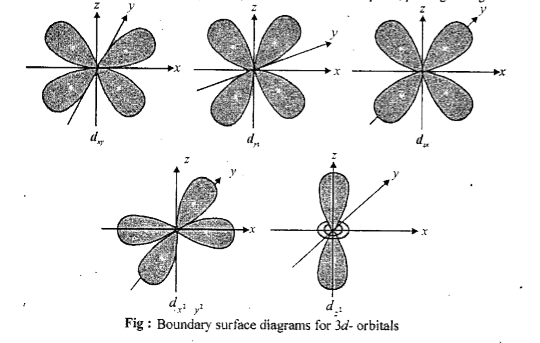Give the boundary surface diagrams of the five 3d-orbitals.Solution in Punjabi
The five d-orbitals are represented as dxy,dyz,dzx,dx2−y2anddz2. The shapes of the first four d-orbitals are similar to each other. All the five d-orbitals are .degenerate orbitals. The d-orbitals are double dumb-bell in shape. The probability density function is zero at the plane, passing through the nucleus.

Topper's Solved these Questions
- BOOK - OMEGA PUBLICATIONCHAPTER - STRUCTURE OF ATOM EXERCISE - MULTIPLE CHOICE QUESTIONS (MCQ s)29videos
STRUCTURE OF ATOM
- BOOK - OMEGA PUBLICATIONCHAPTER - STATES OF MATTER EXERCISE - Multiple Choice Questions (MCQs)29videos
STATES OF MATTER
- BOOK - OMEGA PUBLICATIONCHAPTER - THE P-BLOCK ELEMENTS EXERCISE - MULTIPLE CHOICE QUESTIONS (MCQs)28videos
THE P-BLOCK ELEMENTS
Similar Questions
Emission of β -particle is equivatent to:
15:01View SolutionGas equation PV = nRT is obeyed by
03:02View SolutionWhich of the following configuration is characteristic of group 13- elements ?
03:09View SolutionPressure Diagrams And Force On Boundaries
01:49View SolutionDo atomic orbitals have sharp boundaries ? Explain why or why not ? or Why don't we draw a boundary surface diagram within which the probability of finding the electron is 100% ?
03:53View Solutionएक इलेक्ट्रॉन किसी 3d-कक्षक में हैं। इसके लिए n,l और m1 के सम्भव दीजिए।
02:11View SolutionObserve the given boundary surface diagrams of two orbitals I and II and chosse the correct option.
 01:26View Solution
01:26View SolutionExplain diagrammatically the boundary surfaces for three 2p orbitals and five 3d orbitals.
02:13View SolutionThe shapes of orbital may be represented by boundary surface diagrams. These boundary surface diagram give the most probable regions. S-orbitals are non-directional while p-, d- and f-orbitals have different orientations given by m_l values. These boundary surfaces also have sperical nodes or radial nodes and nodal planes which depend upon the values of n and l. How many orbitals are possible for l = 2 subshell ?
02:49View SolutionThe shapes of orbital may be represented by boundary surface diagrams. These boundary surface diagram give the most probable regions. S-orbitals are non-directional while p-, d- and f-orbitals have different orientations given by m_l values. These boundary surfaces also have sperical nodes or radial nodes and nodal planes which depend upon the values of n and l. How many spherical nodes are present in 3p - orbital?
01:48View SolutionThe shapes of orbital may be represented by boundary surface diagrams. These boundary surface diagram give the most probable regions. S-orbitals are non-directional while p-, d- and f-orbitals have different orientations given by m_l values. These boundary surfaces also have sperical nodes or radial nodes and nodal planes which depend upon the values of n and l. How do 3s and 4s orbitals differ in terms of nodes present in these ?
04:56View SolutionThe shapes of orbital may be represented by boundary surface diagrams. These boundary surface diagram give the most probable regions. S-orbitals are non-directional while p-, d- and f-orbitals have different orientations given by ml values. These boundary surfaces also have sperical nodes or radial nodes and nodal planes which depend upon the values of n and l.
Does d2z orbital has zero electron density in xy plane ?03:31View SolutionThe shapes of orbital may be represented by boundary surface diagrams. These boundary surface diagram give the most probable regions. S-orbitals are non-directional while p-, d- and f-orbitals have different orientations given by m_l values. These boundary surfaces also have sperical nodes or radial nodes and nodal planes which depend upon the values of n and l. How many angular nodes are present in 3d_(yz) orbital?
05:02View SolutionGive the order of filling of electrons in the following orbitals 3p, 3d,4p, 3d and 6s.
04:49View SolutionGive the order of filling of electrons in the following orbitals 3p, 3d,4p, 3d and 6s.
03:54View SolutionGive the order of filling of electrons in the following orbitals 3p, 3d,4p, 3d and 6s.
04:20View Solution

